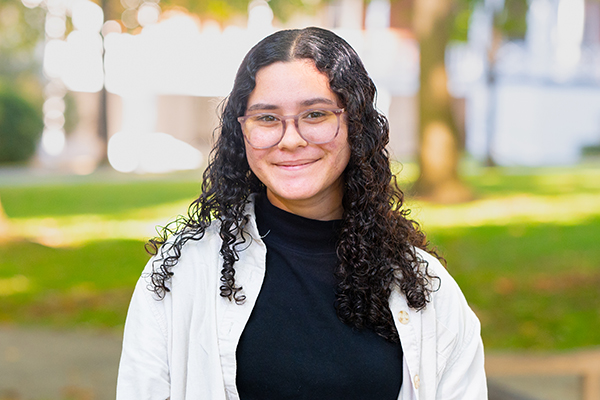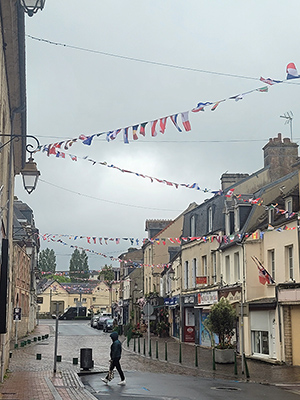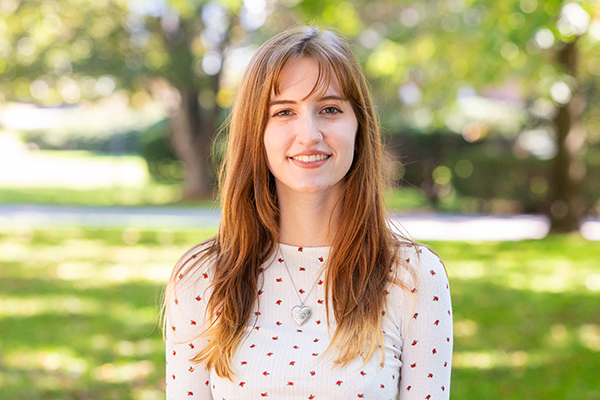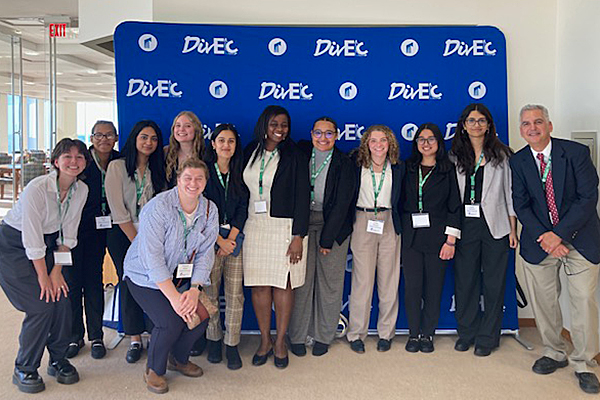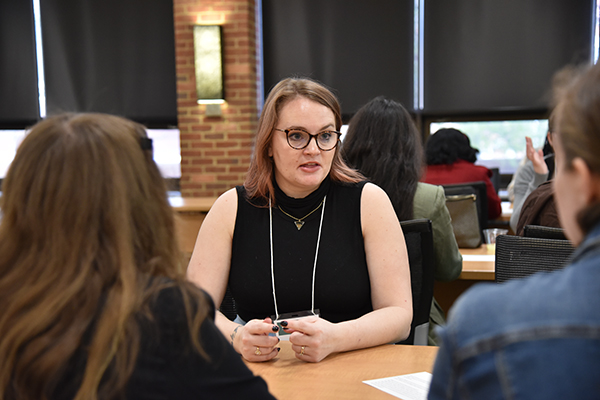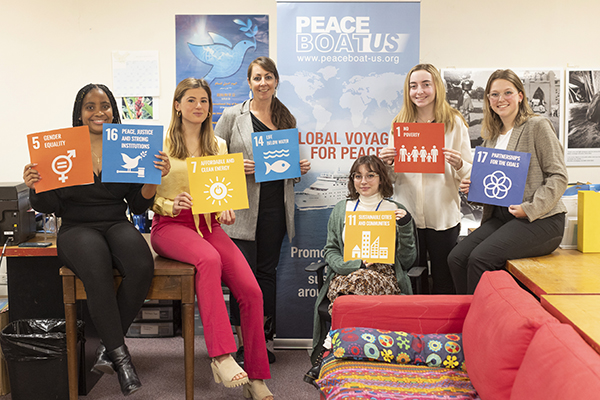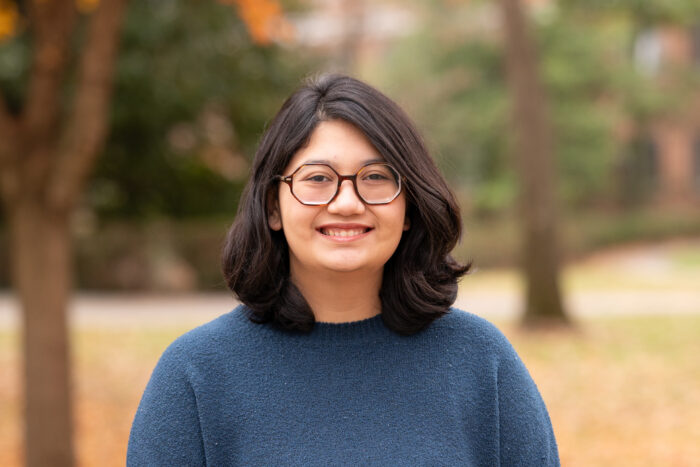Majoring in art history with the encouragement and support to conduct independent study and research is a significant reason why Kailee Hall ‘25 chose to attend Hollins. She was pleasantly surprised to subsequently learn that a second major in international studies would be the perfect complement in achieving her academic goals.
“At first I was hesitant because so much of international studies is centered on economics or politics,” she says. “But after I talked with Dr. Breske (Assistant Professor of International Studies Ashleigh Breske), I realized that I could do more than just policy work. I could focus on cultural heritage. The interdisciplinary aspects of art history and international studies have worked really well together.”
At Hollins, Hall has cultivated a passion for researching identity shaping. “What does it mean to be of an identity, how is this identity portrayed, and will people understand it in the context of indigeneity, which is an association of place, history, and tradition. That makes up the identity of an Indigenous person.”
Hall notes that this research resonates with her on a personal level. “I am myself an Indigenous person. I’m half Maori on my mother’s side, and this research has meant so much and been so helpful to me. I have met so many other Indigenous people and I have seen how they are struggling to preserve and uplift themselves rather than tearing themselves down. That has instilled in me a lot more pride in my identity, and conducting this research has enabled me to understand myself a lot more within my own indigeneity.”
During her research, Hall says she has explored “how we can break away from colonial and post-colonial identities to create a sovereign identity within the framework of indigeneity. How do people see themselves? How do they want to be understood? And how can others recognize their existence as their own identity without associations of other identities?”
A seminal moment in Hall’s journey occurred this summer when she became one of only five interns who were part of the Katzenberger Foundation Art History Internship Program focusing on art history research at the Smithsonian Center for Folklife and Cultural Heritage (CFCH) in Washington, DC. Her application stood out because of her work at Hollins as a mentor with HU Connect, which supports first-generation college students, low/limited-income students, and those who identify as Black, Indigenous, and People of Color (BIPoC) to succeed at the university and beyond.
“I think the program saw CFCH as a good fit for me also because I am familiar with Indigenous visual culture, and I conduct research about Indigenous communities,” Hall says. “CFCH works with communities from different regions and countries and coordinates with them how their heritage and traditions can be showcased.”
Commuting daily to DC from her home in Fredericksburg, Virginia, Hall spent her three-month internship coordinating artist demonstrations for the Smithsonian Indigenous Voices of the Americas Folklife Festival.
“I was working for the most part with basketry artists from Alaska, upstate New York, Michigan, and Louisiana, and also with ceramicists and fabric weavers from Mexico and Peru. I got to spend a lot of time with them and learned about their process, how their ancestral knowledge has been passed down, and how they are trying to preserve these legacies.”
One artist in particular that Hall that interviewed and wrote about and also served as the basis for much of her research over the summer was Kandi McGilton (Mangyepsa Gyipaayg), a Ts’msyen Nation basket weaver based in southeast Alaska. McGilton shared with Hall her efforts to preserve the Ts’msyen Annette Island weaving style along with her language (Sm’algyax) and other practices unique to her community of Metlakatla.
“Kandi wasn’t aware this art form existed until Holly Churchill, daughter of a master weaver named Delores Churchill, told her. Delores tested Kandi’s determination to both learn, maintain, and pass on this ancestral knowledge since the Ts’msyen Annette Island style of weaving is endangered. Kandi possessed the passion needed to keep the technique from becoming extinct. It was great to actually see that in action.”
Other challenges face basketry artists in keeping this art form alive and thriving.
According to the Emerald Ash Borer Network, “Black ash is a cultural keystone species for many Native American and First Nation Tribes….Weaving baskets made from black ash is an integral part of the traditions and identity for many Indigenous families.”
Unfortunately, the “emerald ash borer (an invasive insect that has killed tens of millions of North American ash trees) poses a significant threat to black ash and the traditions surrounding black ash are at risk of being lost along with this prolific tree. As the emerald ash borer spreads and black ash trees die, it becomes more and more difficult for tribal elders and basket makers to pass on the skills and knowledge required for black ash basketry….”
In her work at the Smithsonian, Hall was struck by the commitment of artists from Michigan and New York to keep black ash basketry alive. “They are trying really hard to make sure that younger generations know how to weave baskets even though those trees are endangered. When the black ash is replanted and revived, the documentation will be in place to continue the tradition. There will be no gap in knowledge.”
For Hall, her Smithsonian experience “has definitely expanded how I perceive the field of art history. I saw how anthropologists and ethnomusicologists as well as art historians are creating programs that not only portray artistry but also living folklife”
She adds, “This opportunity has allowed me to learn much about what it means to preserve the heritage of Indigenous communities by working within those communities and seeing how an institution such as the Smithsonian engages in partnerships to preserve heritage practices. I’m thinking I could definitely see myself working in curation in a completely different aspect.”
Currently, Hall is working on senior theses for each of her majors. “For art history, I’m looking at how contemporary Maori artists are using modernism to reshape their identities within indigeneity. It kind of goes hand-in-hand with my international studies thesis, where I’m exploring repatriation, the process of returning stolen or wrongfully sold items back to Indigenous communities. How can we restructure the institutional methods for working with those communities to create mutual partnerships and allow Indigenous communities to create a new form of identity within indigeneity?”
Hall is considering doing at least one or two more internships to build experience before going on to graduate school, and she’s looking forward to applying the skills she’s acquired both at Hollins and the Smithsonian.
“That internship taught me a lot about writing and thinking critically as well as team building. I learned and practiced those skills at Hollins, and I got to apply them at the Smithsonian. That was really helpful.”



